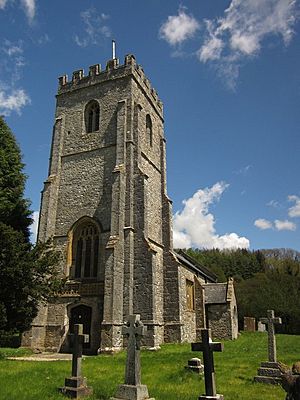Church of St Mary, Wambrook facts for kids
Quick facts for kids Church of St Mary |
|
|---|---|
 |
|
| Location | Wambrook, Somerset, England |
| Built | 13th century |
|
Listed Building – Grade II*
|
|
| Official name: Church of St Mary | |
| Designated | 4 February 1958 |
| Reference no. | 1249439 |
| Lua error in Module:Location_map at line 420: attempt to index field 'wikibase' (a nil value). | |
The Church of St Mary in Wambrook, Somerset, England, is a very old and special church. It was first built in the 1200s! This church is so important that it is known as a Grade II* listed building. This means it is a historic place that needs to be protected.
The church is also known for its unique bell ringers. They practice a special 'clashing' technique. This is where all the bells chime almost at the same time. It is a difficult way to ring bells because the rhythm has to be kept random.
A Look Back: The Church's Story
The Church of St Mary was built in the 13th century. Over many years, parts of it have been changed and updated. In the 1400s, the main part of the church, called the nave, was rebuilt.
Later, in 1812, most of the chancel was rebuilt. The chancel is the area near the altar. Then, in 1892, more work was done to restore the church. This was part of a big movement to fix up old buildings. In 1963, an old entrance area was changed into a small chapel.
The church is part of a group of churches called a benefice. This group includes churches in Chard St. Mary and Combe St Nicholas. This group is part of the Diocese of Bath and Wells. A diocese is a large area managed by a bishop.
What Does It Look Like?
The Church of St Mary is made of stone. It has special stone decorations called hamstone dressings. The roof is made of slate. The church has a nave and a chancel. These are the main parts of the building.
The church also has a tall, three-part tower. This tower is supported by strong walls called buttresses. Inside the tower, there are five bells that can be rung together.
Inside the church, you can see a font from the 1200s. A font is a basin used for baptisms. There is also a gallery at the back of the church. This gallery is held up by strong cast-iron columns.
Outside in the churchyard, there are some old stocks from the 1600s. Stocks were used long ago to hold people as a form of punishment.

